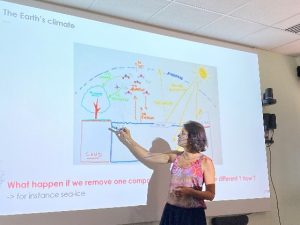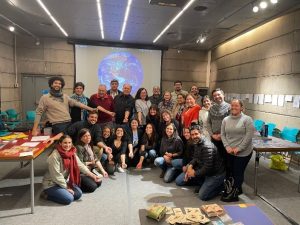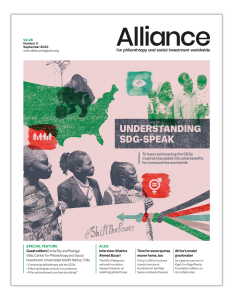‘It would have been extremely helpful if we had been taught a bit more about what’s happening around us as an aftermath of climate change at school. You are very often left alone when it comes to dealing with its impacts. I just don’t think we have that much time to wait for the next generation to stop climate change.’ says a student from the Ludwig-Maximilians University in Munich.
Copyright: Gorodenkoff Productions OU
In my work as the CEO of a philanthropic organisation, I’m glad of the frequent interactions with young people. They keep me abreast of the sentiments of our future generation. As the mother of an 11-year-old, I’m concerned about the looming effect of climate change not only physically but also on the mental well-being of children and young adults.
Cross-cutting SDGs
Siemens Stiftung is an internationally operative foundation with the guiding principle of working together for sustainable social development. We have realigned our strategic focus on three cross-functional key themes of ‘Access to Essential Services’, ‘Connected Societies’ and ‘Climate & Sustainability’ to address the unprecedented changes witnessed in the last few years in a consolidated way. The new topic areas are completely in line with the UN Sustainable Development Goals (SDGs) and through our projects we are breathing life to SDGs like ‘Quality Education’ and ‘Climate Action’.
The ongoing climate crisis has brought science, technology, engineering and maths (STEM) subjects to the fore amongst younger generations, mobilising millions of youths globally, asking the world to ‘unite behind science’. Climate change education is an integral part yet at the same time a complex area of STEM education. It requires comprehensively networked scientific, mathematical and technical knowledge. The interplay between the different impacts of climate change needs to be explored and explained, and efforts need to be consolidated to organise social resilience as an act of solidarity with those most affected by it. It is a universal issue, and mitigating it will require efforts on all fronts, including the arts, and creative methodologies.
’Climate change education is necessarily multidisciplinary. It is not just a strategy for climate change mitigation, but a strategy for transformative climate adaptation of entire societal systems,’ explains Badin Borde, Senior Project Manager, Siemens Stiftung.

Copyright: Office for Climate Education
The STEM+Climate approach
To this end, we are increasingly implementing a ‘STEM + Climate’ approach that addresses the ‘climate action’ goal by enabling access to ‘quality education’ to nurture a better understanding of climate change. The approach stimulates active climate change mitigation and adaptation, by empowering young people to participate in shaping a sustainable future. To illustrate, let me take you to the east-central coast of Mexico in Veracruz. The beautiful and sprawling sandy beaches may ooze holiday vibes, but unfortunately the region is deemed extremely vulnerable to the ravages of climate change. Rising sea levels and coastal erosion are identified as one of the greatest threat to Veracruz’s natural resources, power industry and built environment.
To address the urgent need of sensitizing the local communities on the issue, we have joined forces with the Red STEM Latin America (a network of institutions from governmental, educational, civil, and private sectors – united by the interest of offering quality STEM education) and its members Fondo Golfo de México (Gulf of Mexico Fund), INNOVEC (a non-profit organisation, promoting quality scientific education in public in Mexico), and the Secretary of Education of Veracruz to adopt a three-pronged approach to defining a road map to improve awareness of climate adaptation measures.
Together with our partners, we have been conducting extensive teacher training programmes for 800 teachers from around 300 different schools in Veracruz, benefiting up to 15,000 students. ‘In workshops, STEM teachers are trained to confidently teach the complexities of climate change through active pedagogies integrated with the STEM + Climate approach along with scientific inquiry in project-based learning. Teachers and students conduct experiments and test predictions inside and outside classrooms, gather conclusions, and discuss the various topics like global climate system, impacts of climate change, concepts and measure of mitigation and adaptation critically,’ explains Claudia Robles, Lead at INNOVEC.

Copyright: Siemens Stiftung. Teacher training work organised by OCE and Siemens Stiftung ftung
As a part of such projects, students are encouraged to conduct surveys in the community and work on several initiatives involving their parents and even local authorities. ‘We get students to understand what climate change is, its causes and consequence. The aim is to trigger a domino effect so that the knowledge is transferred from the teachers to the students and their families and the community as a whole,’ adds Claudia Robles. In the process, a whole new generation is empowered to emerge as responsible citizens making informed decisions and lifestyle choices.
SDG 4: Free and flexible quality education
To ensure that teachers have the very latest and high-quality international learning materials, we’ve established long-standing partnerships with key institutions like the Paris- headquartered Office for Climate Education (OCE). Formed as a response to address the global need for climate change education emphasised by the Paris Agreement, OCE coordinates a worldwide network of partners. It educates present and future generations about climate change by supplying them with the tools to understand and act in the face of natural calamities.
One such tool is the Open Education Resources (OER) – innovative online free courses along with teaching and learning materials – giving a 360° perspective on climate change: from origins and mechanisms of climate change to climate systems, ocean and cryosphere and its impacts, as well as solutions. Hosted on an open platform, the resources can be easily adapted for local contexts and downloaded in areas with low to no internet connectivity. It helps primary and middle school teachers to develop solid scientific knowledge and useful pedagogical skills to tackle climate change in the classroom.
David Wilgenbus, Director of OCE adds, ‘For the Veracruz project, we are assisting teachers through education materials on climate change based on the IPCC reports. We also provide considerable professional development opportunities like training sessions and conferences. The teachers need to understand that they are supported by the scientific community but also that they can learn from each other by sharing expertise, experiences, and good practices through peer-to-peer exchange.’
SDG 17: Power of partnerships
Working in partnership

Copyright: Siemens Stiftung
To ensure that our climate change education projects have a lasting impact, I’d allude to Sustainable Development Goal 17 on partnerships. Together with partners from non-profit organisations, universities, local governments and public and private institutions, we organise the International Conference on Climate Change Education in Santiago, Chile. The fifth edition of the conference in May 2023, saw experts from Latin America come together and discuss the importance of integrating climate change education into school curricula, training teachers and developing quality open educational resources. The initiative fosters collaboration between public policy, civil society, economics, science and education to facilitate ‘Building a sustainable future from the school’.
People’s power lies at the heart of our projects, both regionally with the Red STEM Latin America network and internationally through OCE and the International Dialogue on STEM Education. Working in cohesive teams, our partners contribute to the implementation of public policies and educational programmes that integrate climate change education at different levels of education across the region and propose local solutions to global problems. Ultimately the vision is that our joint efforts in Latin America will emerge as a best practice and will influence a paradigm shift on climate change education for the rest of the world.
The climate change education project weaves our three topics areas together and demonstrates their correlation alongside executing the SDGs. We can only prepare our next generation to take on the challenges created by climate change by bringing people and communities together to create pedagogies that capture the zeitgeist of today’s youth and address the human right to education.
To learn more about our work on climate change education, get in touch with Badin Borde, Senior Project Manager, Siemens Stiftung: badin.borde@siemens-stiftung.org
Dr Nina Smidt, Managing Director and Spokesperson of the Board at Siemens Stiftung
The SDGs are the international community’s flagship for social, economic and environmental welfare. If they are to mean anything and if the world is to come anywhere near achieving them, they must meet the real needs of communities in all countries. How effectively is this being done, what are the challenges and what is the role of philanthropy?
Pre-order the issue before its publication on September 5 2023 and get a 20% discount.
Credit:Source link





